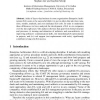Free Online Productivity Tools
i2Speak
i2Symbol
i2OCR
iTex2Img
iWeb2Print
iWeb2Shot
i2Type
iPdf2Split
iPdf2Merge
i2Bopomofo
i2Arabic
i2Style
i2Image
i2PDF
iLatex2Rtf
Sci2ools
ICSOC
2009
Springer
2009
Springer
A Reassessment of Enterprise Architecture Implementation
Abstract. Aside of day-to-day business in some organizations Enterprise Architecture (EA) seems to be successful while it is not in others that also have notations, models, methods, and even dedicated EA tools. In order to understand these differences we have analyzed the development of EA in six companies over the last eight years. Our analyses showed, that apart from formal structure and processes (i) training and education of architects and non-architects, (ii) improving architects' communication skills, (iii) intensifying EA representation in projects, and (iv) tool support (not replacements with tools), significantly contribute to long term EA success.
Applied Computing | EA Tools | ICSOC 2009 | Term Ea Success | Tools |
| Added | 19 Feb 2011 |
| Updated | 19 Feb 2011 |
| Type | Journal |
| Year | 2009 |
| Where | ICSOC |
| Authors | Stephan Aier, Joachim Schelp |
Comments (0)

